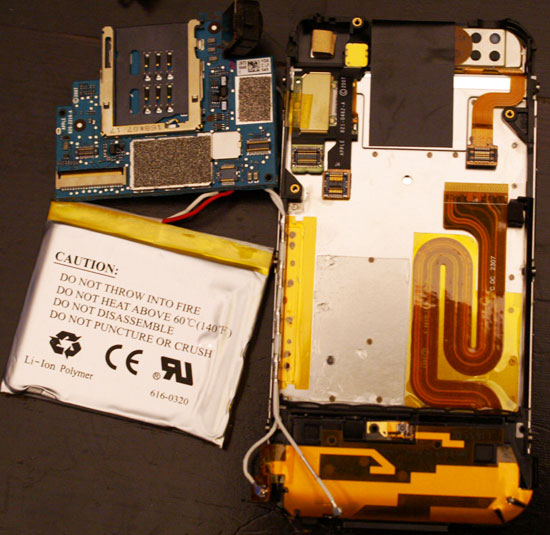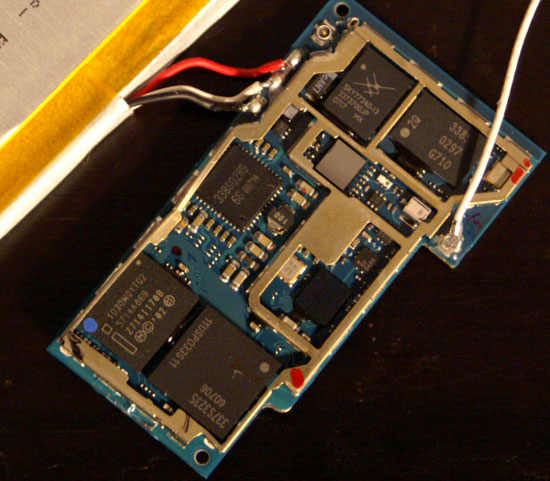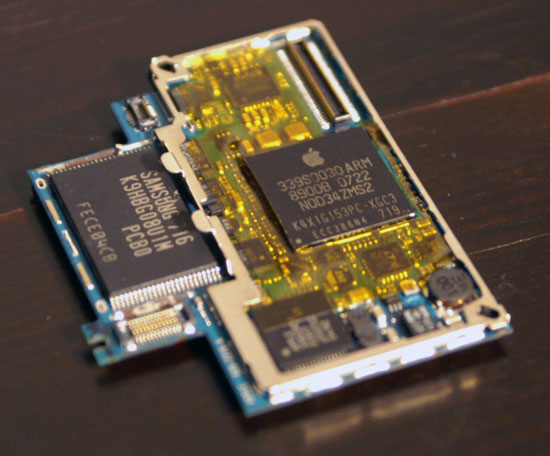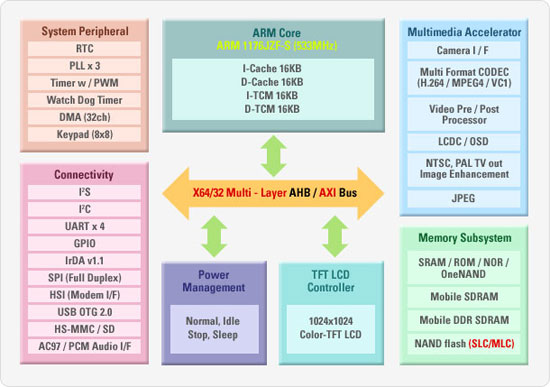Apple's iPhone Dissected: We did it, so you don't have to
by Anand Lal Shimpi on June 29, 2007 10:17 PM EST- Posted in
- Smartphones
- Mobile
The iPhone's Motherboard(s)
The motherboard in the iPhone is very compact; it is actually composed of two separate PCBs that are sandwiched together.

The upper left hand corner of the picture is the PCB sandwich that makes the iPhone tick; the black slot you're seeing here is for the SIM card; the cable port on the lower left of the motherboard appears to be the LCD interface.
The topmost PCB appears to have the 802.11b/g wireless controller as well as most of the other microprocessors necessary for the cell phone aspects of the iPhone:

Note that we've removed the EMI shield from the top of this PCB layer in order to show off the individual components.

The lower PCB layer features the 4GB MLC NAND Flash (made by Samsung), as well as the iPhone's main processor. Two of the chips on this board have Apple logos on them, the larger of the two appears to be the iPhone's ARM processor manufactured by Samsung.

We suspect that it may be Samsung's S3C6400 based on the ARM1176 core, however some readers have written us stating that it's more likely to be the S3C2460; judging by the model numbers on the chip itself, the ARM processor may be a part of a multi-chip package that includes 1Gbit of system memory, for running the iPhone's OS. The K4X1G153PC-XGC3 is a Samsung part number, indicating a 1Gbit memory device, but it is placed on the same package as the ARM processor itself.











39 Comments
View All Comments
p1agu3 - Wednesday, August 5, 2009 - link
The reason I know anandtech is one of my favorites on the web:It's 2009. I see a news article: http://www.dailytech.com/article.aspx?newsid=15880">http://www.dailytech.com/article.aspx?newsid=15880
I began wondering about the internals of an iPhone, as it had dawned on me that I'd never actually seen their guts before. So I immediately googled (to the right of my address bar...in Firefox) "iphone internals" and clicked on the first result. It brought me here...back to Anandtech again. Good job, guys and gals, and especially Anand: your hard work in consistent journalism is paying off. Thank you! :)
p1agu3 - Wednesday, August 5, 2009 - link
My bad, I neglected to mention I saw said news article from its mention in an anandtech article. whoops, haha. anyways, hopefully now that makes sense.alora222 - Monday, February 2, 2009 - link
Try the TripChill iPhone travel assistant the next time you travel. Get real-time flight alerts, book hotel and car, view alternate flights, notify friends of travel status, manage your itinerary, and much more.==========
alora
http://www.tripchill.com">http://www.tripchill.com
mikeepu - Friday, July 13, 2007 - link
Just a little FYI on iPhone BatteriesFrom Jason Snell's Article "The truth about iPhone battery lifespan":
"A true statement, as far as it goes. Batteries die. But many media reports this week have gone further. Take, for example, CNET’s review of the iPhone, which states that “Apple is estimating one battery will last for 400 charges — probably about two years’ worth of use.”
Two years of use, the review says, and your iPhone dies. Or disappears in a puff of smoke, like those old tape recordings on “Mission Impossible.” Sounds pretty awful, right?
Too bad it’s completely wrong.
Apple estimates that the iPhone will lose 20 percent of its capacity — a darn sight less than 100 percent — “after 400 full charge and discharge cycles.”
“Sadly, there are some inaccurate reports out there,” Apple marketing vice president Greg Joswiak told me today during a brief phone call from New York City. Joswiak isn’t quite sure where the story went off the rails — David Pogue’s initial New York Times review of the iPhone mentioned the battery issue, but Pogue got it right: “Apple says that the battery starts to lose capacity after 300 or 400 charges.”
Somehow, though, things got lost in translation. And follow-on reports started claiming that 300 to 400 charges would be the end of the line.
“After 400 complete cycles, the iPhone’s battery still has 80 percent of its charged capacity,” Joswiak said. “And by a complete charge cycle, I mean completely draining the battery, a full chemical cycle.” In other words, using a little battery and then putting your iPhone back in its dock doesn’t count as a charge cycle. If you use a quarter of your iPhone’s battery and then re-charge it, Joswiak said, that’s the equivalent of a quarter of a charge cycle.
“If you top it off, you’re not wasting a charge cycle,” Joswiak said."
http://www.macworld.com/weblogs/macword/2007/07/ip...">The Truth about iPhone Battery Lifespan
CptanPanic - Thursday, July 5, 2007 - link
Has anyone seen a dissection of the dock? I want to see if there is any electronics in there. There is supposed to be some sort of authentication chip to tell iphone that dock is iphone compatable.Roy2001 - Tuesday, July 3, 2007 - link
So, are you able to put all parts back and make it work again?Xenoterranos - Monday, July 2, 2007 - link
I can think of 4 things you didn't do in this tear down, and all of them involve the battery...gregor7777 - Monday, July 2, 2007 - link
Wow, the non-user changeable battery is a real problem methinks.Apple is set to make a lot of money on that deal. The customer has to go without their phone for an unspecified period of time, foot a relatively hefty bill and then probably repeat the process a year later.
Model 2 has a user replaceable battery? Let's hope so.
EODetroit - Monday, July 2, 2007 - link
I remember when it was a one-man show. Now just hope for a blog update... maybe an update on the value of the iPhone next?Googer - Monday, July 2, 2007 - link
Engadget has confirmed the iPhone's processor.http://www.engadget.com/2007/07/01/iphone-processo...">http://www.engadget.com/2007/07/01/iphone-processo...
http://www.arm.com/products/CPUs/ARM1176.html">http://www.arm.com/products/CPUs/ARM1176.html